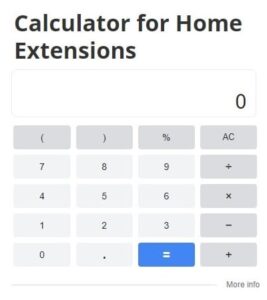
Renovating your entire home can be an exciting yet daunting project. At Home Owners Association, we often get questions about the costs involved in such a significant undertaking.
The entire home renovation cost can vary widely depending on several factors, including the scope of work, materials used, and your location. In this post, we’ll break down the key elements that influence renovation expenses and provide practical tips to help you budget effectively for your home transformation.
What Drives Home Renovation Costs?
Project Scope and Size
The extent of your renovation is the primary cost driver. A complete home overhaul will cost more than updating a single room. Single-storey extensions can cost between $1,500 to $2,500 per m², while double-storey extensions range from $1,700 to $2,700 per m². Refreshing a single bedroom might only set you back $2,000 to $5,000.
Material Quality and Finishes
Your choice of materials and finishes can dramatically affect your budget. High-end materials like marble countertops or custom cabinetry will increase costs substantially. Kitchen renovations can range from $25,000 to $50,000 (with a significant portion attributed to cabinetry and appliances). Opting for mid-range materials can help keep costs down without sacrificing quality.
Labor and Contractor Fees
Professional labor is a substantial part of any renovation budget. In Australia, hiring renovation builders typically costs between $50 to $85 per hour, varying by location and job specifics. Structural renovations often require council approval, which may involve a progress payment schedule rather than a lump sum payment.
Location and Market Conditions
Your location plays a key role in determining renovation costs. Construction costs typically fall between AUD 1,200 to AUD 3,500 per square meter for residential projects, with metropolitan areas often seeing higher prices. Urban areas with higher living costs generally see higher renovation expenses due to increased labor and material costs.
Hidden Costs and Contingencies
Always budget for unexpected expenses. We recommend setting aside about 3% of the total contract value as a contingency fund. This is particularly important when renovating older homes, where unforeseen issues are more likely to occur.
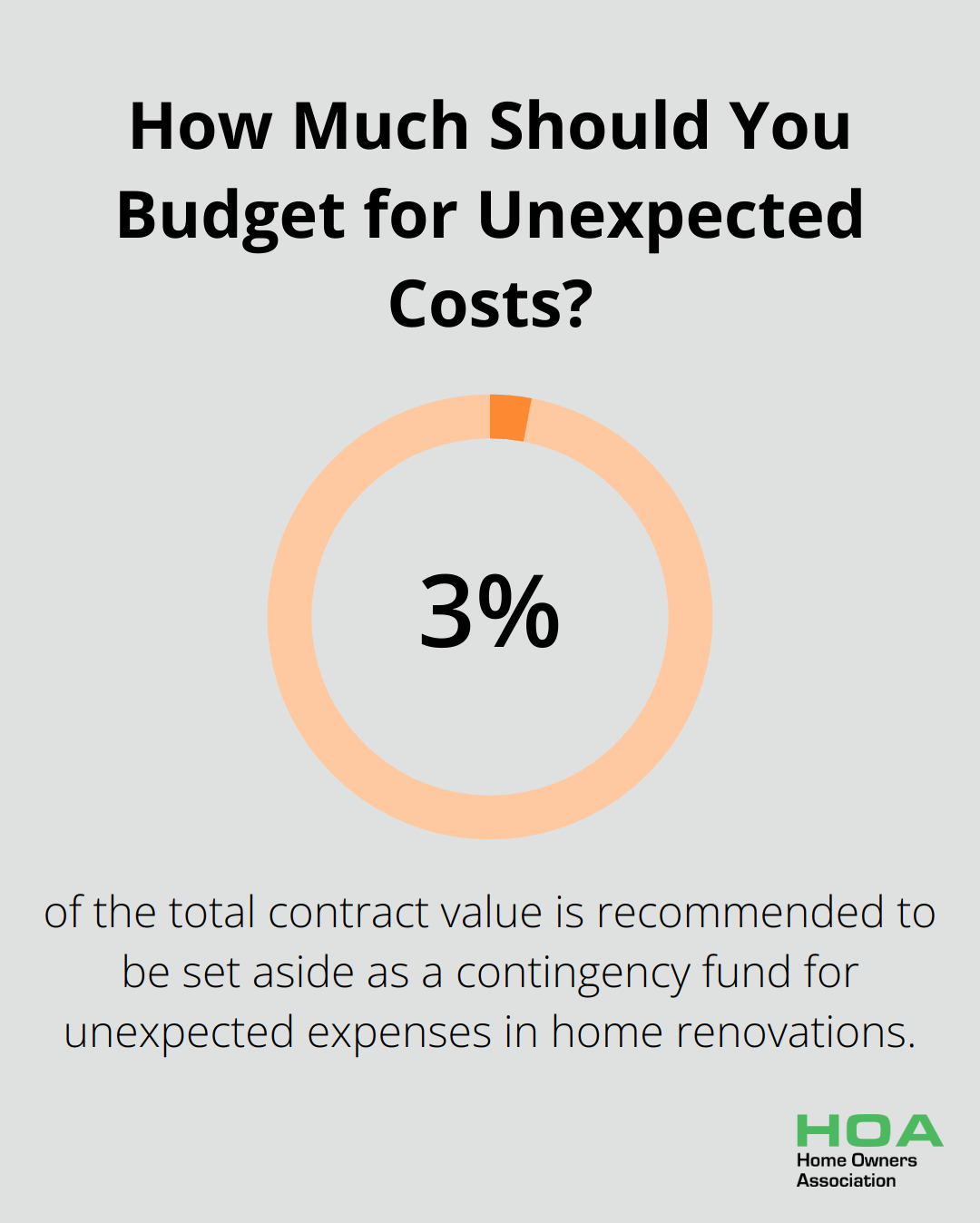
Understanding these factors will help you develop a more accurate budget for your home renovation project. While it’s tempting to cut corners to save money, investing in quality materials and skilled labor often pays off in the long run, both in terms of durability and potential increase in property value. Now, let’s explore the average costs for different types of home renovations to give you a clearer picture of what to expect.
What Are Typical Costs for Home Renovations?
Kitchen Renovations: The Heart of Your Home
Kitchen renovation costs range from $5,000 for budget makeovers to $45,000+ for high-end projects, with factors like materials, labour, and design complexity influencing the final price. This price range includes new cabinetry, appliances, countertops, and flooring.
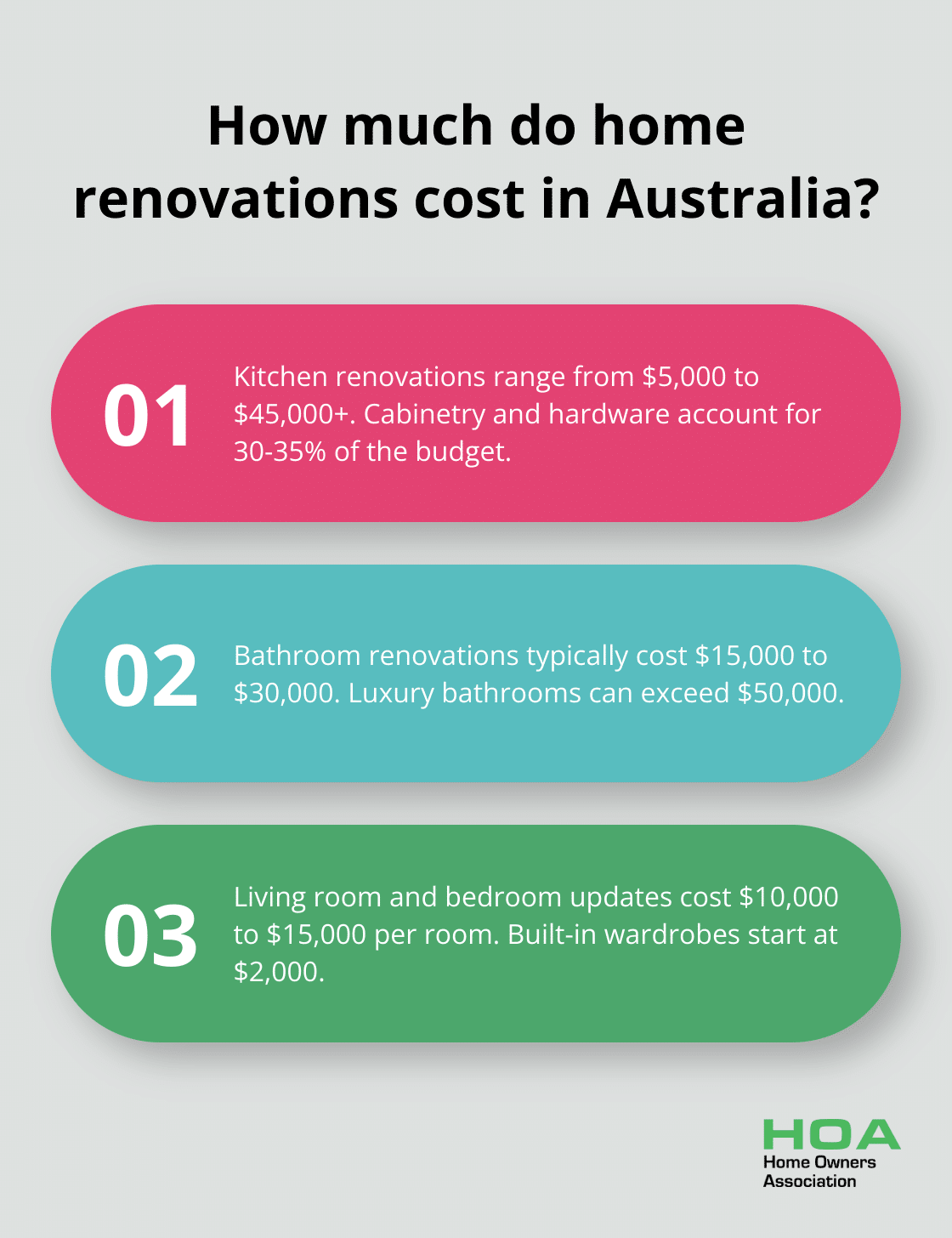
A typical kitchen renovation budget breaks down as follows:
- Cabinetry and hardware: 30-35%
- Appliances and ventilation: 20-25%
- Countertops: 10-15%
- Installation: 15-20%
- Additional expenses (flooring, lighting, etc.): 10-15%
Bathroom Remodels: Small Space, Big Impact
Bathroom renovations in Australia typically cost from $15,000 to $30,000 for a standard-sized bathroom. This includes new tiling, fixtures, and paint. Luxury bathrooms with high-end finishes can cost upwards of $50,000.
Key factors that influence bathroom renovation costs include:
- Size of the bathroom
- Quality of fixtures and fittings
- Extent of plumbing changes
- Type and quality of tiles
Living Room and Bedroom Updates
Renovating living rooms and bedrooms costs less than kitchens and bathrooms. Costs for these areas range from $10,000 to $15,000 per room. This typically covers new flooring, paint, lighting, and minor structural changes.
For bedrooms, built-in wardrobes add significant value but also increase costs. A basic built-in wardrobe starts at around $2,000, while a custom-designed wardrobe system can cost $10,000 or more.
Exterior Renovations and Landscaping
Exterior renovations enhance your home’s curb appeal. Here are some common exterior projects and their average costs:
- Roof replacement: $15,000 to $30,000
- Exterior painting: $10,000 to $20,000 for a two-story home
- New windows: $8,000 to $15,000 for a standard home
- Landscaping: $5,000 to $20,000 (depending on the size of the yard and extent of work)
These average costs can vary significantly based on your location, the size of your home, and the quality of materials chosen. It’s wise to get multiple quotes from reputable contractors before starting any renovation project.
Home Owners Association members often save 10-20% on their renovation costs through trade discounts and expert advice. This can make a substantial difference in your overall budget, especially for larger projects.
Now that we’ve covered typical renovation costs, let’s explore some effective strategies to save money on your home improvement projects without compromising on quality.
How to Cut Costs on Your Home Renovation
Plan Thoroughly and Prioritize
Before you start your renovation, create a detailed plan. Identify which improvements are essential and which are optional. Focus on projects that add the most value to your home. For example, updating your kitchen or bathroom typically offers a better return on investment than a luxury pool.
Consider DIY for Simple Tasks
While complex jobs require professionals, you can tackle many tasks yourself. Painting, simple tiling, or installing new light fixtures are all manageable DIY projects that can save you hundreds, if not thousands, of dollars.
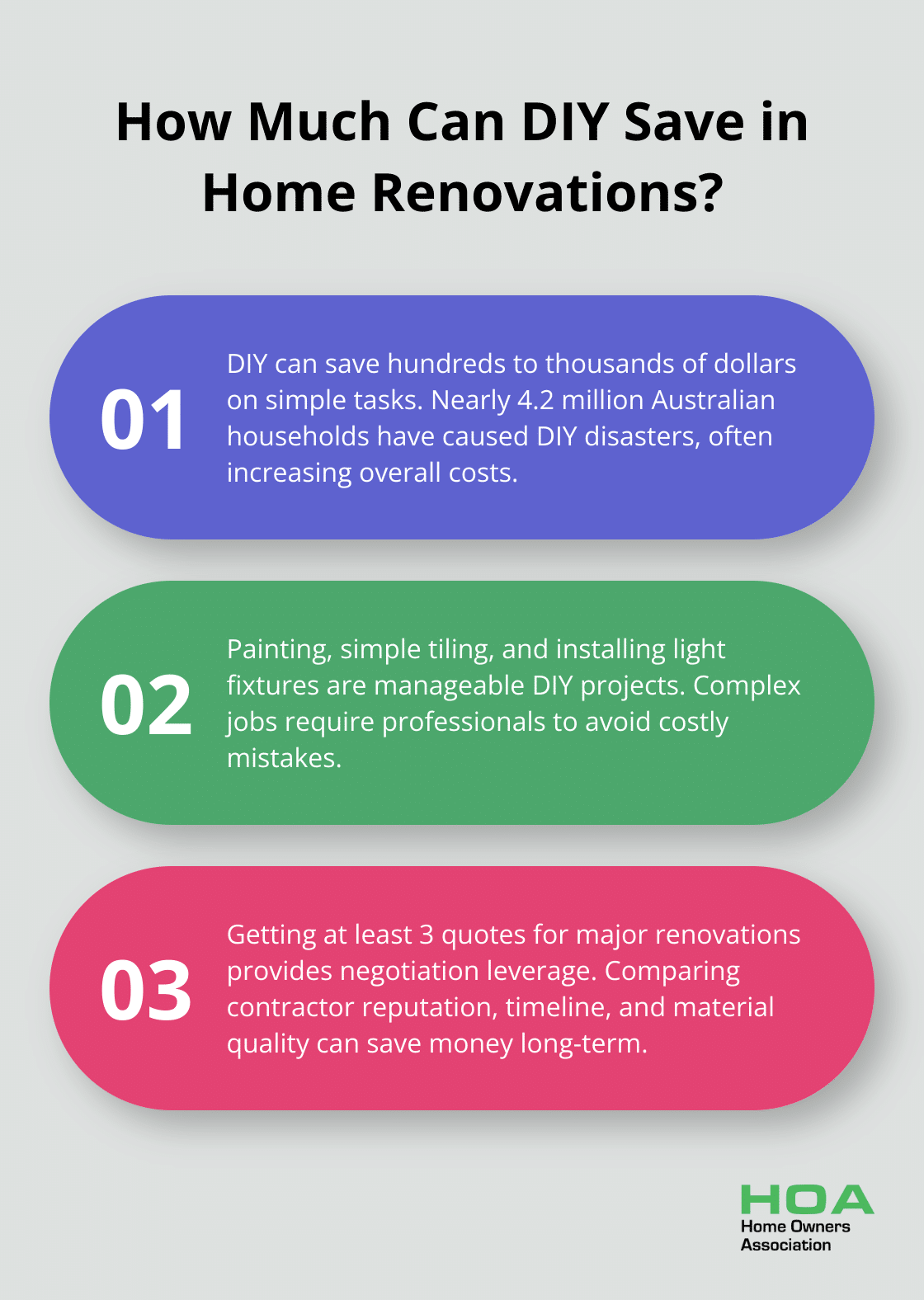
However, be realistic about your skills. Attempting DIY on tasks beyond your expertise can lead to costly mistakes. A national survey from Australia’s largest online tradie marketplace, hipages, found that nearly 4.2 million households had caused a DIY disaster, often resulting in higher overall costs.
Hunt for Deals on Materials
You can find substantial savings by shopping around for materials. Look for end-of-line sales, clearance items, or slightly imperfect products that are still functional. Many suppliers offer significant discounts on bulk purchases (which can be beneficial for larger projects).
Online marketplaces and recycling centers often have affordable, quality materials. You might find gently used appliances or surplus building materials at a fraction of the retail price.
Get Multiple Quotes and Negotiate
Don’t settle for the first quote you receive. Get at least three quotes for each major aspect of your renovation. This not only gives you a better understanding of fair market prices but also provides leverage for negotiation.
When comparing quotes, look beyond the bottom line. Consider the contractor’s reputation, timeline, and the quality of materials they propose. Sometimes, paying slightly more for a reputable contractor can save you money in the long run by avoiding costly mistakes or delays.
Seek Expert Advice
Professional guidance can help you allocate your budget more effectively. Organizations like Home Owners Association offer expert advice on prioritizing renovations, ensuring you get the most value for your money. They can also provide access to a network of pre-vetted contractors, potentially saving both time and money in the selection process.
Final Thoughts
An entire home renovation cost depends on various factors such as project scope, material quality, labor fees, and location. Homeowners must consider these elements to create a realistic budget and avoid unexpected expenses. Proper planning and prioritization of essential improvements will help maximize the value of your investment.
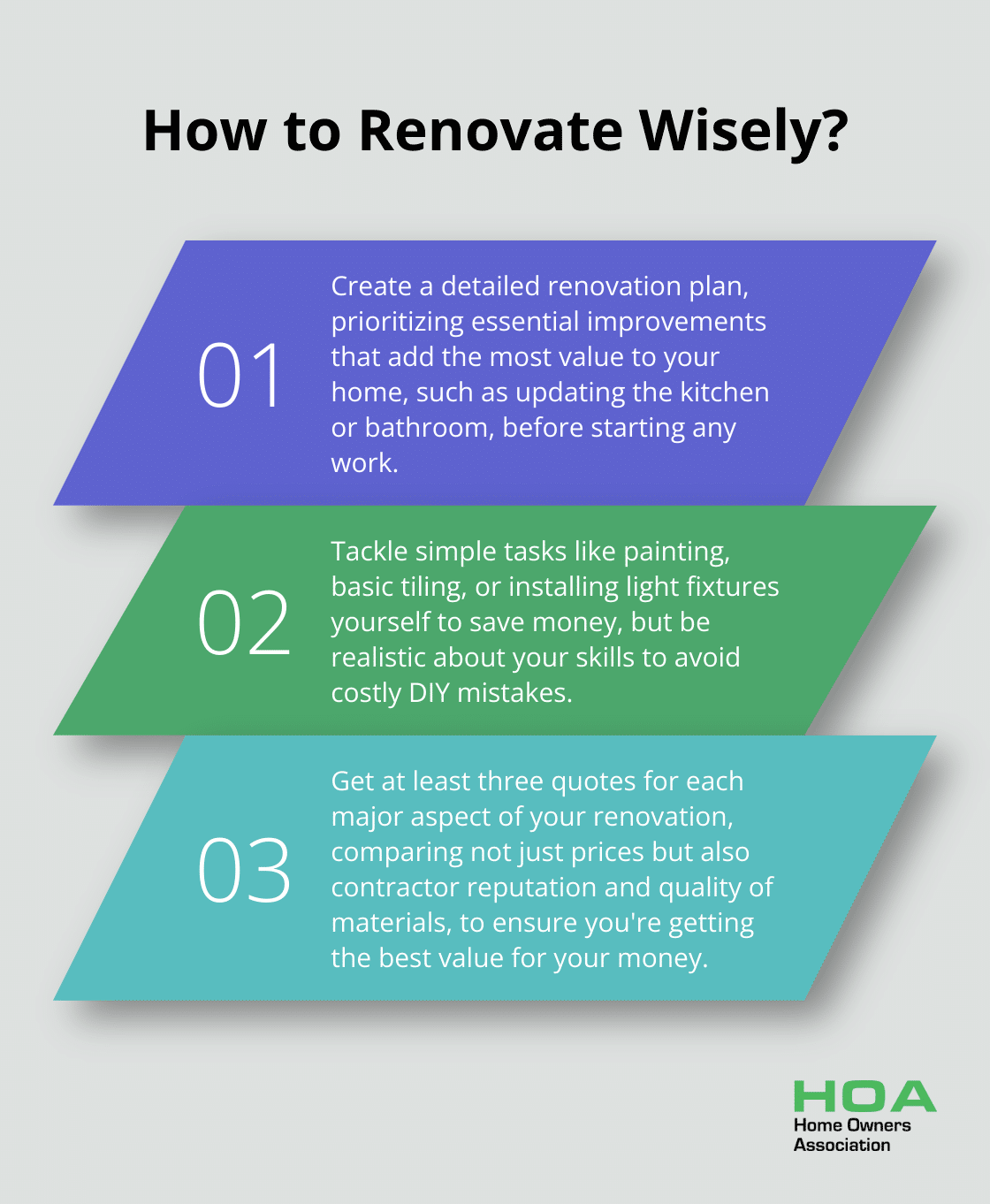
Home Owners Association offers support for homeowners in Melbourne who want to navigate the complexities of home renovations. Members can reduce their entire home renovation costs through access to trade pricing, discounts on materials, and expert advice. The association’s guidance and resources empower homeowners to make informed decisions throughout their renovation journey.
Homeowners can transform their properties while managing their budgets effectively with careful planning and expert support. Implementing cost-saving strategies and leveraging the benefits of Home Owners Association membership will help achieve renovation goals without overspending. Careful consideration of all aspects will lead to a successful home transformation project.





